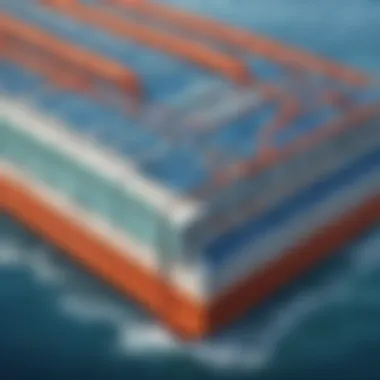Understanding the Ocean Conveyor Belt: Climate Impact


Intro
The ocean conveyor belt, or thermohaline circulation, is an intricate system driving the movement of ocean water around the globe. This movement is crucial for maintaining climate balance and supporting marine life. In this article, we will explore various aspects of this vital mechanism. We will discuss its science, impacts, and even some fun facts to engage young minds.
Science Fun Facts
Thermohaline circulation is an essential part of Earth's climate system. Here are some interesting trivia and facts about it:
- The ocean conveyor belt can take thousands of years for a complete circulation to occur. This means that water from the surface can take ages to reach the depths and then come back up again.
- Did you know that the term "thermohaline" refers to temperature and salinity? These two factors influence the density of sea water, contributing to the sinking and rising movements.
- One of the most famous currents in the conveyor belt is the Gulf Stream. It helps warm the eastern coast of North America and parts of Europe.
"The ocean conveyor belt is a climate regulator that helps distribute heat globally, affecting weather and ecosystems on land and sea."
- The ocean conveyor belt also plays a role in carbon cycling. Ocean waters can absorb CO2, which impacts climate change positively when balanced.
- The movement of warm water brings not only heat but also nutrients, supporting a diverse array of marine life.
Quirky Science Stories
In the late 20th Century, scientists realized that the ocean conveyor belt was crucial in understanding past climate changes. Ice core samples from Antarctica showed fluctuations in temperature over hundreds of thousands of years. Researchers linked these changes to alterations in ocean circulation patterns.
Discover the Wonders of Science
By exploring thermohaline circulation, one can appreciate how interconnected various scientific concepts are. Here are some engaging ways to learn more:
- Educational Videos and Animations: Platforms like YouTube have visual content explaining ocean currents in detail. Watching how water moves globally helps solidify concepts.
- Interactive Learning Tools: Websites like NASA and National Geographic offer interactive maps and simulations, showing real-time ocean currents and their effects on climate.
- Real-Life Applications of Science: Understanding this system is essential for addressing climate issues. It helps predict weather patterns and informs conservation efforts.
Science Quiz Time
To test your understanding of the ocean conveyor belt, here are a few questions:
- What does the term thermohaline refer to?
- Which famous current is part of the ocean conveyor belt?
- A. Temperature and salinity
- B. Wind and wave
- C. Ocean floor and currents
- A. The Amazon River Current
- B. The Gulf Stream
- C. The Antarctic Current
End
The ocean conveyor belt is not just about water movement; it is a fundamental process that affects climate and marine biodiversity. Understanding how it works helps us appreciate the delicate balance of our planet's ecosystems. Stay curious and keep exploring!
Foreword to the Ocean Conveyor Belt
The ocean conveyor belt is an essential concept in understanding how our planet's climate works. This natural system of ocean currents plays a critical role in regulating temperature, distributing nutrients, and supporting marine life. As we delve into this topic, we will highlight the mechanisms and functions of the ocean conveyor belt and explore its historical significance and contemporary importance.
Definition and Overview
The ocean conveyor belt, often referred to as thermohaline circulation, is a large-scale movement of water driven by changes in temperature and salinity. This circulation is significant because it maintains the balance of heat across the oceans, helping to influence global climate patterns. In simpler terms, warm water from the equator flows toward the poles, while cold, denser water sinks and returns to the equator at greater depths. This continual flow creates a loop that impacts weather systems and climate stability.
Historical Context
The concept of the ocean conveyor belt has evolved over centuries. The early study of ocean currents can be traced back to the explorations of sailors who noted the influence of currents on their travel routes. More sophisticated understandings began in the 19th century when scientists, such as Matthew Maury, mapped the ocean's currents and laid the groundwork for later research.
In the 20th century, with advancements in oceanographic research, the visibility of these currents improved. The work by researchers like Wallace Broecker popularized the term "ocean conveyor belt," emphasizing its role in climate systems. This historical progression helped define the significance of ocean currents in maintaining life and the balance of ecosystems in the oceans.
Underlying Mechanisms
Understanding the underlying mechanisms of the ocean conveyor belt is crucial as it reveals the forces driving this essential global system. It is a complex interplay of temperature, salinity, and wind, each contributing significantly to how ocean currents behave. This section discusses two fundamental aspects: thermohaline circulation and wind influences. Together, these mechanisms give insight into not only how ocean currents work but also their implications on climate and marine ecosystems.


Thermohaline Circulation
Thermohaline circulation refers to the movement of ocean water driven by variations in temperature and salinity, two key factors that affect water density. Warm, less salty water is lighter and stays near the surface, while cold, salty water is denser and sinks. This creates a global conveyor belt, rejuvenating currents beneath the oceans.
The process begins at the surface of the ocean, mainly in polar regions where the water cools. As temperatures drop, sea ice forms, leaving behind saltier water that increases the water density. This denser water begins to sink, effectively starting the conveyor belt. The journey of these deep currents can take hundreds to thousands of years, eventually returning to the surface in different regions of the world.
Key points to note about thermohaline circulation include:
- Importance for Climate: It plays a vital role in regulating Earth's climate. By redistributing heat from the equator toward the poles, it balances temperatures across the globe.
- Supporting Marine Life: The upwelling of nutrient-rich water from the depths sustains marine ecosystems and promotes biodiversity, crucial for the health of oceans.
"Thermohaline circulation is an essential process, ensuring that the ocean remains a dynamic and balanced system, powering both climate and life underneath the waves."
Wind Influences
Wind also has a significant impact on the ocean conveyor belt. It generates surface currents that move warm water toward cooler areas. When wind blows over the surface of the ocean, it pushes the water in the direction of the wind.
These surface currents interact with thermohaline circulation in important ways. For instance, as warm water is displaced towards the poles, it cools and eventually contributes to the denser water that sinks. Wind-driven currents help in maintaining the overall movement of water, ensuring the conveyor belt remains in motion.
Some factors to consider about wind influences include:
- Energy Transfer: Winds transfer energy to the ocean, affecting temperature and currents. This dynamic reshapes weather patterns globally.
- Variability: Winds can vary seasonally or due to climate events like El Niño, altering the flow of the ocean conveyor belt.
The interplay between thermohaline circulation and wind is a powerful reminder of how interconnected and fluid our climate systems are. Together, these mechanisms underpin the critical roles oceans play in regulating temperature and supporting life.
Components of the Ocean Conveyor Belt
The ocean conveyor belt consists of various components that work together to regulate the Earth’s climate and support marine ecosystems. Understanding these parts is vital for recognizing how the ocean influences weather patterns and life in the sea.
Surface Currents
Surface currents are the upper layer of the ocean which generally move in circulation patterns. These currents primarily originate from wind and play a crucial role in regulating climate. For instance, the Gulf Stream transports warm water from the Gulf of Mexico towards the North Atlantic. This warm water influences coastal climates, making them milder, particularly in regions like Western Europe.
The movement of surface currents can also distribute heat from equatorial areas towards poles. This redistribution is essential for maintaining temperature balance across the globe. Without these currents, some regions would experience extreme cold or heat. Surface currents also affect marine life by distributing nutrients and warmer water, which impacts habitats.
Deep Ocean Currents
Deep ocean currents are often driven by differences in temperature and salinity in the water column, a process known as thermohaline circulation. These currents operate at depths below the surface and are crucial for transporting colder water to the depths of the ocean. This deep circulation helps to convey nutrients necessary for marine life.
The Antarctic bottom water is one of the densest waters and plays a major role in deep ocean currents. Understanding these currents is necessary to appreciate how they influence global climate. Changes in deep currents can lead to alterations in heat distribution, affecting weather patterns significantly.
Key Regions of Interest
Several regions are vital to the operation of the ocean conveyor belt. These include:
- The North Atlantic: Here, warm waters from the Gulf Stream cool and sink, contributing to deep ocean currents.
- The Southern Ocean: Surrounding Antarctica, this area is critical for the formation of dense water masses.
- The Arctic Ocean: This region is experiencing changes due to climate alterations which impact the overall conveyor belt system.
Therefore, observing these key regions helps in understanding how the ocean conveyor belt functions and its implications for climate change. "Monitoring these areas can provide valuable insights into changes in oceanic systems and their effects on global climates."
The Role in Climate Regulation
The ocean conveyor belt, notably the thermohaline circulation, is integral to the stability of our planet's climate system. It operates as a vast conveyor of heat, transporting warm water from the equator to polar regions while bringing cold water back to the tropics. This balancing act is vital, as it regulates global temperatures and affects weather patterns.
Heat Distribution
One of the primary functions of the ocean conveyor belt is its role in heat distribution. The ocean absorbs solar energy and carries it away from the equator. This process is crucial; without it, tropical regions would become excessively hot, and polar areas would experience even harsher cold. The movement of warm water allows for a milder climate in Europe and North America, making them more habitable.
Here are the key points on how heat distribution works:


- Warm Surface Currents: As warm water flows poleward, it releases heat to the atmosphere. This process warms the air above it, influencing climate in adjacent regions.
- Cold Deep Currents: As water cools in polar regions, it becomes denser and sinks. This cold water moves back towards the equator, maintaining the balance and even cooling the areas it flows through.
- Effect on Coastal Areas: Coastal regions often experience moderated temperatures because of the ocean's heat exchange. This influences agriculture and ecosystems along the coasts, which often rely on stable climate conditions.
"The ocean is a key climate regulator, influencing both global temperatures and local weather patterns."
Impact on Weather Patterns
The influence of the ocean conveyor belt on weather patterns is significant. Changes in the ocean currents can lead to variations in precipitation and temperature worldwide. When the conveyor belt slows down or changes direction, it can result in extreme weather events.
Some important points to consider are:
- El Niño and La Niña Phenomena: These natural climate patterns are heavily influenced by the ocean conveyor belt. They can lead to severe conditions such as droughts or floods across different parts of the world.
- Increased Storm Intensity: A warming ocean can lead to warmer air temperatures, which increase the energy available for storms. This can result in more intense hurricanes and tropical storms.
- Regional Climate Changes: Different regions respond uniquely to shifts in ocean currents. For instance, a change in the conveyor belt may lead to increased rainfall in one area while causing drought in another.
Understanding how the ocean conveyor belt regulates climate and weather patterns underscores its importance to our environment. It's not merely a physical system; it profoundly shapes the conditions in which we live.
Influence on Marine Ecosystems
The ocean conveyor belt greatly impacts marine ecosystems, influencing nutrient availability and supporting biodiversity. Understanding this influence is crucial, as it forms the foundation for healthy oceans and, by extension, for life on Earth.
Nutrient Distribution
The movement of water in the ocean conveyor belt directly affects how nutrients are distributed across different ocean regions. Areas of upwelling, where deep, nutrient-rich waters rise to the surface, play a significant role in marine productivity. In places like the Eastern Pacific and the coasts of Peru, these rich waters bring essential nutrients that fuel the growth of phytoplankton, which forms the base of the ocean food web.
Without a proper nutrient supply, larger organisms like fish cannot thrive. It is vital to maintain the balance of nutrient distribution. This intricate system is highly sensitive and can be affected by changes in ocean currents and temperatures. Factors such as climate change pose a threat to these nutrient-rich areas, affecting not only marine life but also the livelihoods of people who depend on fishing.
Biodiversity Support
The ocean conveyor belt also supports marine biodiversity by creating various ecological niches. Different ocean zones, influenced by the conveyor belt's circulation, host unique species adapted to specific conditions. For instance, warmer waters might support coral reefs, while colder areas may harbor different types of fish and marine mammals.
A diverse ecosystem is more resilient, able to withstand environmental changes better than a single-species system. Higher biodiversity contributes to the stability of ecosystems. It helps in maintaining the balance of ocean life, thus ensuring that species interactions, such as predator-prey relationships, function effectively.
"Biodiversity is essential for a healthy ocean and provides critical services that support both marine life and human communities."
Promoting biodiversity through marine protected areas or sustainable fishing practices is essential for preserving these ecosystems. The influence of the ocean conveyor belt extends beyond mere water movement; it enables a flourishing web of life that is vital for the planet's health.
Interconnected Systems
Understanding interconnected systems is vital when examining the ocean conveyor belt. This concept emphasizes the connections between the ocean's currents and various global phenomena, particularly climate change and its effects on marine life.
Climate Change Interactions
The ocean conveyor belt significantly interacts with climate change. As global temperatures rise due to greenhouse gas emissions, the properties of ocean water change. Warmer water is less dense than cold water, which can disrupt the balance of the conveyor belt system. When the conveyor belt slows, it can lead to extreme weather conditions in different parts of the world. For example, certain regions may experience harsher winters or intensified storms.
- Altered precipitation patterns: Changes in ocean currents can influence rainfall distribution. Some areas may face increased flooding, while others suffer droughts.
- Sea level rise: Melting ice sheets contribute more freshwater to the ocean. This further affects the density and flow of ocean currents.
- Marine heatwaves: Warmer sea temperatures can lead to more frequent marine heatwaves, affecting marine ecosystems profoundly.
"The ocean conveyor belt is a critical factor in climate regulation; its disruption could lead to significant global consequences."
Impact on Global Currents
The ocean conveyor belt also plays a crucial role in influencing global currents. It connects various ocean basins and affects the movement of warm and cold water across the planet. The interaction between surface currents and deep-sea currents creates a complex network that helps to redistribute nutrients and maintain marine ecosystems.
- Warm currents: These currents carry warmth from the equator to higher latitudes, impacting local climates. For instance, the Gulf Stream warms the eastern United States and parts of Europe.
- Cold currents: They transport cooler water from polar regions, impacting the oceanic and atmospheric temperatures in the regions they flow.
- Nutrient loops: The mixing of warm and cold currents supports the distribution of nutrients necessary for marine life, sustaining biodiversity.
In summary, the interconnected systems of the ocean conveyor belt illustrate the importance of understanding how climate change and global currents are interrelated. This knowledge is essential for predicting future shifts in global climate patterns and marine ecosystems.
Current Research and Discoveries
Studies related to the ocean conveyor belt are vital, as they help us understand the intricacies of climate dynamics and marine ecosystems. These studies employ advanced technologies and frameworks, revealing insights into how natural systems respond to changing conditions. Research in this field not only informs climate models but also points to potential strategies for addressing adverse effects from climate change.


Innovative Methodologies
Recent advancements in oceanography have led to the development of innovative methodologies for studying the ocean conveyor belt. Researchers are using autonomous underwater vehicles, satellite observations, and sophisticated modeling techniques. These tools allow scientists to gather detailed data on ocean currents, temperature variations, and salinity levels.
For example, the deployment of Argo floats, which measure temperature and salinity at various depths, has transformed our understanding of deep ocean currents. This technology can cover vast areas of the ocean, providing real-time data that is critical to studying complex oceanic systems.
Additionally, remote sensing using satellites helps track surface currents and their impact on climate. High-resolution imagery allows scientists to visualize patterns and changes in ocean circulation over time, making it easier to connect findings with climate effects.
Recent Findings
The latest studies on the ocean conveyor belt have revealed critical findings that alter our understanding of ocean dynamics. Research shows that changes in freshwater input from melting ice in Greenland can slow down the conveyor belt’s flow. This slowdown impacts global climate and leads to extreme weather conditions in various parts of the world.
Another significant discovery is the role of ocean circulation in supporting marine biodiversity. Areas with strong currents often coincide with regions rich in nutrients, which are vital for the ecosystem. By mapping these connections, scientists are beginning to predict how oceanic changes will affect fish populations and marine life.
Recent research has highlighted that climate change could disrupt the delicate balance of marine ecosystems, revealing a need for vigilance and action.
This ongoing research is essential as it informs policies aimed at protecting marine environments while contributing to climate adaptation strategies. The collective efforts in this area aim to provide solutions that benefit both ecosystems and human societies.
Challenges Facing the Ocean Conveyor Belt
The ocean conveyor belt faces significant challenges that can have profound impacts on global climate systems and marine life. Understanding these challenges is essential for grasping the future of our oceans and, by extension, our planet. This section focuses on two main pressures: global warming effects and pollution caused by human activity. Both are critical topics that deserve attention as they reshape everything from ocean temperatures to biodiversity.
Global Warming Effects
Global warming is altering the delicate thermal balance of the ocean. As the atmosphere warms, so too does the ocean. This increase in temperature can disrupt thermohaline circulation, which serves as a temperature-regulating mechanism for Earth. Warmer waters can reduce the ocean's ability to absorb carbon dioxide, creating a feedback loop that exacerbates climate change. The melting of polar ice caps contributes fresh water into salty ocean systems. This freshening can hinder the sinking of cold, salty water critical for maintaining circulation patterns.
Key implications of these changes include:
- Altered Current Patterns: The speed and direction of ocean currents can shift, impacting weather systems globally.
- Changes in Marine Habitats: Warmer oceans can lead to habitat loss for many species, particularly those adapted to specific temperature ranges.
- Potential for More Extreme Weather: Disruption of currents can lead to increased frequency and intensity of storms.
"The ocean’s health is closely tied to the planet’s climate stability. Changing one affects the other."
Pollution and Human Impact
Human activity has introduced various pollutants into the ocean, affecting the ocean conveyor belt and marine ecosystems. Plastics, heavy metals, and chemical runoff infiltrate marine environments, resulting in detrimental effects. For example, excessive nutrient runoff leads to algal blooms, which can produce toxins and create dead zones—areas so depleted of oxygen that aquatic life cannot survive.
Important aspects related to pollution include:
- Chemical Contaminants: Many industrial processes discharge heavy metals and other toxins into waterways, contributing to ocean pollution.
- Microplastics: These tiny particles enter the food chain, affecting marine organisms and the health of the oceanic ecosystem.
- Oil Spills: Catastrophic events such as oil spills have immediate and long-lasting effects on marine life and coastal economies.
Efforts to mitigate these impacts focus on stricter regulations, community clean-up initiatives, and increased awareness regarding sustainable practices. While progress is being made, the combined effects of global warming and pollution pose significant threats to the ocean conveyor belt and must be addressed urgently.
Future Outlook
Understanding the future outlook of the ocean conveyor belt is essential for grasping how changing environmental conditions might affect global systems. As climate change continues to evolve, researchers are focused on predicting how these changes will affect thermohaline circulation and, consequently, Earth's climate and marine ecosystems. The significance of examining these potential shifts cannot be overstated.
Predicted Changes
The ocean conveyor belt is not a static entity; it is influenced by various factors that create fluctuations in its flow. Some of the predicted changes include:
- Weakened currents: Many studies suggest that as polar ice melts due to increasing temperatures, the influx of fresh water into the ocean may disrupt buoyancy levels. This can slow down the conveyor and alter its traditional pathways.
- Rising sea levels: As global temperatures rise, the thermal expansion of water will likely impact the depth and dynamics of ocean currents. This can produce unpredictable weather patterns and alter precipitation rates across different regions.
- Increased frequency of extreme weather: It is expected that the modifying effects on ocean currents will lead to more intense and frequent storms, floods, and droughts. These developments pose significant risks to human life, food supply, and global economies.
"The ocean conveyor belt influences climate patterns globally, making its future more important to investigate as environmental changes proceed."
Understanding these predicted changes helps researchers and policymakers identify potential consequences and devise appropriate environmental strategies.
Importance of Preservation
Protecting the ocean conveyor belt requires recognition of its crucial role in global climate stability and marine life. Here are key aspects to consider in emphasizing its preservation:
- Ecological health: The ocean conveyor belt is vital for the distribution of nutrients. Alterations in its flow may jeopardize marine biodiversity, affecting fish populations and disrupting food webs.
- Climate moderation: A stable ocean conveyor belt helps regulate temperatures globally. Preventing further disruption could maintain a balance in climate patterns, reducing the harsh impacts of climate change.
- International cooperation: Given the shared nature of ocean currents, international collaboration is essential. Countries must work together to implement policies addressing carbon emissions and pollution, which may further destabilize the system.
Preserving the integrity of the ocean conveyor belt is paramount for sustaining life on Earth. Through informed actions and policies, a future can be secured where marine ecosystems thrive, and climate stability is prioritized.







